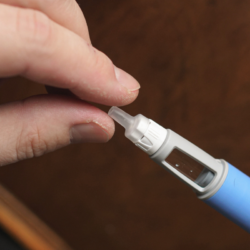This article aims to question a worrying social phenomenon targeting adolescent girls and their relationship to weight loss diets or any other measure to lose weight.
In Western societies, teenage girls are assaulted with images of girls with dreamy bodies. The cult of beauty as well as the frequent use of diets are all aspects which characterize individualism and which also apply to the particular case of adolescent girls. Indeed, body appearance is of capital importance in the life of many adolescent girls to the point that 80% of girls have dieted before the age of 18 (National Institute of Nutrition, 2003).
To reach the dream weight, women and teenage girls use various strategies. Diets and methods for losing weight are highly publicized. All these advertisements, televised or posted on social networks, sell dreams. The beauty ideal conveyed in the media is that of a woman who is very thin, young and, let’s say it, without physical flaws. This woman with the ideal body is almost non-existent in the flesh on the planet. However, some teenage girls try to achieve this unattainable ideal of beauty. It seems that the advertisements and especially the messages conveyed therein have a real impact on the lives of teenage girls. Indeed, the media and fashion nowadays exert real pressure on young girls.
Adolescent girls and vulnerability:
Many young girls aspire to the idealized body of models when we know that this body is not accessible to all. Several of them are taking steps to comply with this model. To change their appearance and lose weight, they do not hesitate to put themselves voluntarily in danger to achieve their goals: food deprivation, appetite suppressant pills, vomiting, strict diets, etc. Some inevitably fall into the trap of anorexia nervosa.
Those who do not meet this norm may suffer from social exclusion by their peers and experience situations of anxiety. On the other hand, those who meet the standard can just as easily experience situations of anxiety, because they want to keep the gains. Thus a vicious circle sets in.
The links between identity and body:
Adolescent girls are in a period of self-discovery and identity formation. The period of adolescence is between 10 and 19 years. It seems that body image is becoming more and more important in the lives of young girls. By placing too much emphasis on their body image, today’s teenage girls will experience many disappointments in their lifetime as the body changes a lot.
The body has become a form of identity marking. This shows the importance given to the body in our societies. When an individual is in a process of identity creation, he experiences tensions between the desired identity, the assigned identity and his real identity.
Self-esteem is no longer based on shared common values, but on the gaze and judgment of peers.
Adolescent girls and sources of influence:
- Groups (friends, peers and family):
The group implies the notion of integration. Indeed, “each individual has an identity which is proper to him, but the strength of the group can transform it or help it to constitute itself”, that is to say that a person belonging to a group can change. to comply or can continue in his quest for personal identity. In addition, the concept of group also implies the notion of individual autonomy, as it is rare for a person to belong to a single group throughout his life. The groups (work, school, religion, family, leisure, arts, sports, etc.) to which it belongs change and can also intersect (belonging to several groups at the same time).
It is certain that peer groups take on incomparable importance in the lives of young people in adolescence. In addition, adolescent girls form, in part, their personal identity through their interpersonal relationships and comparisons.
Teenage girls with a great concern for their body image often band together and influence each other. Peer attitudes contribute significantly to the prevention of individual behaviors regarding body image and eating behaviors. Adolescent girls inform each other about weight loss strategies, participate in speeches about their bodies, normalize inappropriate eating behaviors and compare themselves to other girls in their group, but also to the girl. the most popular of the school.
The influence of parents is essential, whether direct or indirect. Parents and the family at large must be involved in the development of the young girl who becomes a teenager and then a woman.
-
The body and the fashion:
Clothing practices are not strictly consumer practices: indeed, clothing practices are simultaneously modeling and shaping actions of the human body. We try to get as close as possible to the ideal body through clothing. Clothing that is fashionable, however, has certain characteristics.
Everyone has come across, in recent years, scantily dressed young girls, even naked. Reactions to this phenomenon may differ. In addition, makeup and an elaborate hairstyle complete the portrait. To dress this way, a few body characteristics are required, one of which is thinness.
Indeed, these clothes are designed to be worn by thin people. In this phenomenon, the preoccupation with the clothing is not the concern to cover one’s body, but rather with the appearance of the body in the clothing. It is not the clothes that adjust to the body, but the body that must adjust to this fashion.
The clothes that are currently in fashion add additional social pressure on teenage girls to achieve the ideal body and to adhere to different weight loss techniques.
The consequences of this phenomenon on mental health:
As a result of malnutrition, psychological and behavioral effects become observable in the short term: they feel bad about themselves, they lack attention, they feel a strong disinterest, they feel very irritable and despite their best efforts, are very disappointed with the results. There is also a change at the emotional level reflected in changes in mood, anxiety, depression, mistrust as well as a feeling of ineffectiveness.
A latent danger is that diet and thinning become an obsession. Appearance and thinness can become an obsession that can push the girl into anorexia. This is an excessive preoccupation with weight and figure. The obsession not to gain weight, the compulsion not to eat and to participate in sports to lose weight more.
Of all the psychological disorders, eating disorders are the ones that cause the most deaths!
The biological consequences of this phenomenon:
Biologically, malnutrition affects almost the entire body. Quite quickly there is of course a great loss of weight and an irregularity in the menstrual cycle. Amenorrhea usually occurs after three months, sleep disorders are also noticed: insomnia, restless sleep, nervousness, voluntary vomiting and the use of laxatives also have serious physiological consequences resulting in hemorrhages, fatigue, constipation, bloating. The functioning of the kidneys and the brain is disturbed, and muscle spasms appear.
The hematological system is also affected by anemia (decrease in red blood cells in the blood and their hemoglobin content) and also leukopenia (decrease in white blood cells in the blood). Sometimes there is erosion of the tooth enamel (secondary to the action of stomach acids when the person makes themselves vomit), in addition to enlargement of the salivary glands.
In the endocrine system there may be an increase in prolactin and a decrease in gonadotropins. On the nervous system side, seizures, as well as a lowering of the body temperature (hypothermia) are likely to occur. Some other complications, also common are even more serious, it can occur, among others a disturbed heart rhythm, heart failure, cardiac arrest, cerebral atrophy and extreme weight loss.
Advancing under the gaze of her peers, with fear of rejection, today’s teenager shapes her identity according to her image. She navigates the aisles of the consumer society and equips herself with brands, a style, tattoos … But if appearances suggest that she is the craftsman of her choices and beliefs, with a unique personality, she does not. nonetheless remains an ideal marketing target for which advertisements are intended for the values of this adolescent culture in which “to be yourself, you have to be like the others”.
To pursue their impossible ideal, they are able to go beyond the limits of their own body. corps.







